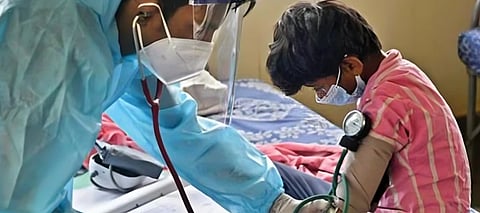HMPV virus in India: Why infants or babies are more at risk for severe illness?
The COVID-19 pandemic led to a long lockdown across the world and also resulted in the death of lakhs of people. After recovering from this pandemic after about 4 years, the world is finally breathing a sigh of relief. However, another virus has raised concerns across the world. As per reports, China is grappling with another serious medical emergency four years after the outbreak of the deadly COVID-19 pandemic. The cause of this pandemic is a virus called Human Metapneumovirus (HMPV).
Due to this virus, many countries are monitoring its spread. Along with the world, India has also started monitoring it. On January 6, the HMPV virus was detected in an eight-month-old girl in a hospital in Bengaluru. While two babies were found positive in Bengaluru, one baby has been tested positive in Ahmedabad, Gujarat. Now, the question arises as to why infants are more at risk of severe illness due to HMPV virus. Below is everything you need to know-
Why infants are more at risk of HMPV virus?
As per reports, anyone can be infected by HMPV virus. However, certain age groups are more at risk of HMPV virus. This includes individuals who are younger than 5, particularly premature infants, or older than 65. Those with weakened immune systems, due to conditions like HIV, cancer, autoimmune disorders, or immunosuppressive medications, as well as individuals with asthma or COPD, are also more vulnerable to complications from the virus.
Is HPMV deadlier than COVID-19?
The University of California has termed HPMV as 'little known'. Talking about whether it is deadlier than COVID, Larissa May, a professor of emergency medicine and an expert in public health and testing for infectious diseases was quoted saying in a University of California report, "HMPV is not something most people need to worry about. It’s essentially another cause of the common cold."
However, it is also a fact that there is currently no vaccine for HMPV, and nor are there any forms of antiviral therapy used to treat it. HMPV is usually treated by doctors by focusing on caring for the symptoms, with the hope that the body can then beat the virus on its own.
What is happening in China?
The number of respiratory patients in China has increased rapidly. Children and the elderly are being affected the most by this. Young children, whose immune systems are not yet fully developed, are particularly susceptible. The elderly or people with conditions such as asthma or COPD (Chronic Obstructive Pulmonary Disease) are also at higher risk. The elderly or people with conditions such as asthma or COPD are also at higher risk. Its symptoms are similar to those of the flu or a cold, including fever, cough, runny nose, and sometimes wheezing.
As per the official statement of India, "Union Health Ministry is monitoring the situation through all available surveillance channels. ICMR will continue to track trends in HMPV circulation throughout the year. The World Health Organization (WHO) is already providing timely updates regarding the situation in China to further inform ongoing measures. The recent preparedness drill conducted across the country has shown that India is well-equipped to handle any potential increase in respiratory illnesses and public health interventions can be deployed promptly if needed.”

